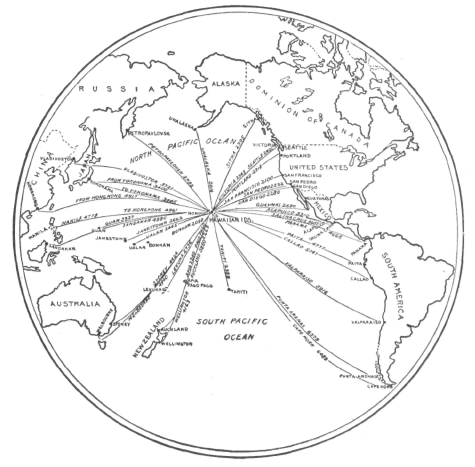HAWAIIAN ISLANDS 849 HAWAIIAN ISLANDS
Description
This page of the book is from "The New Student's Reference Work: Volume 2" by Chandler B. Beach, Frank Morton McMurry and others.
HAWAIIAN ISLANDS 849 HAWAIIAN ISLANDS
tion, many of them bordered, though not surrounded, by coral reefs. The larger islands are mountainous, and Hawaii, the largest, contains the high mountains of Mauna Kea (13,805 feet) and Mauna Loa (13,675 feet). The area and population of the several islands are as follows: Hawaii 4,210 square miles (pop. 55,382); Maui 760 square miles (pop. 25,416); Oahu 600 square miles (pop. 82,028); Kauai 590 square miles (pop. 23,952)l Molokai 270 square miles; Lanai
150 (pop. of the two isles, 2,504) ; Ninau 97 square miles (pop. 172); and Kihulaue 63 square miles. The total area is about 6,640 square miles; the total population (1910) 191,909. There are many Japanese, Chinese and Koreans on the islands; but English is the language in general use in the schools. The natives are chiefly Christians. Climate and Products. The climate is fairly temperate, the mercury seldom rising above 90° F. and, in the cooler season, rarely falling below 520. The valleys are beautiful
and highly fertile, and are covered with sugar, cotton and rice plantations. The commerce of the islands is gradually increasing.
Exports. In 1876 a reciprocity treaty was concluded with the United States, which led to an enormous development of the sugar-export trade. The other chief articles of export are rice, wool, molasses, tallow and bananas.
History. The islands are said to have been found by Gaetano in 1542, and were re-
discovered by Captain Cook in 1778. Formerly each island was governed by a separate king, but early in the 19th century, under Kamehameha I, they were united into one kingdom, whose ruler was vested with almost absolute power. This so remained until about 1886, when the powers of the king were greatly curtailed. Another Kamehameha, who died in 1874, was succeeded by Kalakaua. The latter died in 1891, and was succeeded by Queen Liliuokalani, who was deposed in January, 1893. The republic



